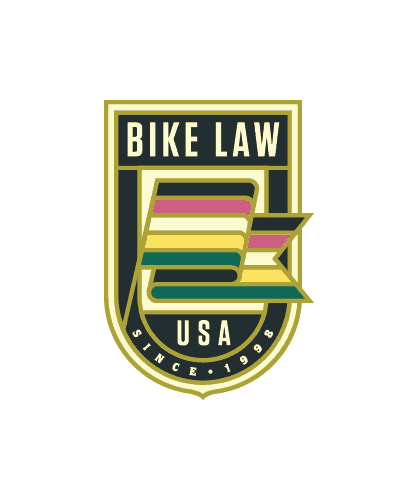It’s important to know your legal rights (and duties) when bicycling in Kansas. It is especially important after a bicycle accident (we call them bicycle “crashes” and explain why here).
This is a general overview of Kansas’s bicycle laws. To see them in their completion, please visit Kansas’s Department of Transportation. Feel free to reach out to Bike Law’s National Director Rachael Maney for further information.
Right to the Road
Bicycles are not defined as vehicles but bicyclists generally have all the rights and duties as motor vehicle drivers.
Where to Ride
- Bicyclists are required to ride as near to the right-hand edge of the roadway as practicable, when traveling slower than the speed of traffic. When on a one-way road, bicyclists may ride as near to the left side of the roadway as practicable.
- Full lane use is allowed when traveling at the normal speed of traffic, preparing for a turn, overtaking and passing, avoiding hazards, and traveling in a lane too narrow to share.
- Bicyclists must utilize any usable path for bicycles that has been provided adjacent to a roadway.
- Kansas state law does not permit or prohibit bicycles on the sidewalks. Check local ordinances for variations on this rule.
HOW TO RIDE
- Bicyclists shall not ride more than two abreast except on paths or parts of roadways set aside for the exclusive use of bicycles.
- Bicyclists are required to slow down and come to a complete stop at stop signs and traffic devices signaling red. In the event of inoperative red lights and after a reasonable period of time, bicyclists may proceed through the inoperative red light. (Dead Red)
- Bicyclists must signal when turning or coming to a stop.
Bicyclists Overtaking Cars
Bicyclists on roadways must exercise due care when passing a standing vehicle or one proceeding in the same direction.
Cars Overtaking Bicyclists
Motor vehicle drivers are required to pass bicyclists not less than three (3) feet clearance. Motor vehicles may pass a bicyclist in a no-passing zone but the motorist has a duty to execute the pass only when safe.
Equipment
- At night, a bicycle must be equipped with a front white light visible from at least 500 feet and a rear red reflector, visible from 600 feet away. A rear red light may be used in addition to the rear reflector, which must be visible from 500 feet away.
- Bicycles must be equipped with brakes which will enable the operator to make the braked wheels skid on dry, level, clean pavement.
Prohibitions
- Clinging to motor vehicles while bicycling is not permitted.
- Bicyclists may not carry anything which prevents keeping at least one hand on handlebars.
- A bicycle may not carry more than the number of persons for which it is designed.
- Bicyclists may not ride other than upon or astride a permanent and regular seat attached to the bicycle.
Bicycling Under the Influence (BUI)
Kansas’ State Supreme Court ruled that the State’s DUI law does not apply to bicyclists, although Wichita’s City DUI ordinance does apply to bicyclists.
